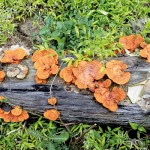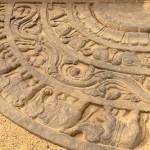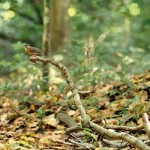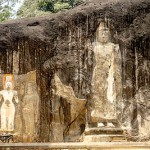Encounter with wild beauty
View(s):- Arrenga Nadaraja explores the little visited Lahugala National Park
On a warm morning at the end of March looking to escape the stifling Colombo heat, we set out to Lahugala Kitulana National Park. Declared as a wildlife sanctuary on July 1, 1966, it was gazetted as a national park on October 31, 1980.
Covering an extent of 5131 hectares and located in the Ampara district, this small wildlife reserve is noted for its elephants and bird life and its magnificent landscape with tall trees. It is also home to three reservoirs – Lahugala, Kitulana and Sengamuwa – the waters of which come together and empty into the Heda Oya.
From Colombo, it took about six hours to make the journey of around 380 km to Lahugala. We took the Southern Expressway from Kottawa, exited at Mattala and then headed straight on to the Thanamalwila area.
- Dash of colour: Wild mushroom
- Moonstone at Magul Maha Viharaya. Pic by Arrenga Nadaraja
- Spot the Brown-capped babbler. Pic by Luxshman Nadaraja
- On the way to the park: Buduruwagala Raja Maha Viharaya
On our way, driving past bright green paddy fields, with small kades lining the roadsides, we stopped to visit the ancient Buduruwagala Raja Maha Viharaya close to Wellawaya, where people had come dressed in white, for worship and reflection. On this same road we encountered a peahen with two chicks. To our surprise, one of the chicks hopped onto its mother’s back, which was a first ever sighting for us.
Stopping at Monaragala town for some last minute shopping, we passed Siyambalanduwa before reaching Lahugala Kitulana.
Other routes from Colombo are through Nuwara Eliya – Badulla – Monaragala or Colombo – Galle – Matara – Hambantota – Wellawaya and Monaragala.
The entrance to the park is small and located at the back of the park office, a compact building painted in green on the outside (as most park offices are).
We had made a booking online for the Mahawewa Wildlife circuit bungalow through the Wildlife Circuit Bungalow reservation e-service. The only one in the park, the bungalow is located about 10 minutes from the entrance. We had brought provisions and a cooler box (for meats, fish etc) needed for a two night stay, and the bungalow keeper prepared our meals. For one night at the park, it costs Rs. 11,446 with other charges on top of that. A game ranger is assigned to be your guide. If you’re staying in a park bungalow, your park entrance fee is covered.
It was late afternoon when we got to the bungalow to be greeted by the sight of an elephant in the Mahawewa. Grey herons, Painted storks and Brahminy Kites had taken over the wewa and two large crocodiles were basking in the sun on the bank at a distance with deer grazing by.
On our second day, we visited Karanda Oya campsite, and spotted an eagle soaring above in the scorching sun. We walked barefoot on the hot sandbank towards the water that had dwindled but what remained was cool to the touch. What was refreshing was that we didn’t encounter a lot of vehicles as one usually does in other more visited national parks.
The park has two dry spells from May to October and January to March as we discovered; it was unbearably hot late afternoon and at night.
The endemic animals to look out for here are the toque monkey, Tufted Grey Langurs, sloth bears, Golden jackals, Slender Loris, Rusty spotted cat, Fishing cat, Indian Muntjac and Indian Pangolin. The park is also known for endemic birds such as the Serendib Scops Owl, Ceylon Blue Magpie, Ceylon Grey Hornbill, Brown-capped babbler, Red Faced Malkoha, Sri Lanka Spurfowl, Layard’s Parakeet, Sri Lanka Hanging Parrot and Crimson-backed flameback.
Writing in ‘A Wild Life Interlude’ Volume Two by S.D. Saparamadu, former game ranger Peter Jayawardena describes memorable encounters with elephants in Lahugala: “Once I have seen two big bulls fight for supremacy over an area. One was an old bull of about 10ft. and the other a young animal around 8ft.”
In the same account he also says “The few tanks around Lahugala contain a species of grass called ‘beru’ which grows in water. Beru seems to be the great attraction for elephants. Sometimes the local elephants walk into the tanks and keep on feeding on beru from dawn till dusk. Often only their backs are seen above water level.
Sadly we didn’t see as many elephants as hoped. The elephants are not around these days due to the height of the water in the reservoirs and the lack of beru grass that they like to eat, a game ranger told us.
The ancient Magul Maha Viharaya is just eight minutes from the park by car. It lies in the north edge of the Lahugala park, about 11km from the nearest town, Pottuvil. Jeeps are available at Pottuvil and accommodation as well for travellers.
As our stay came to a close, we decided we should visit again to experience more of what this small but beautiful park offers.
Searching for that next furry family member but couldn’t find one in your area? Hitad.lk has the solution with our extensive listings of dogs for sale in Sri Lanka!






